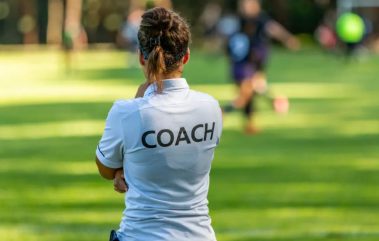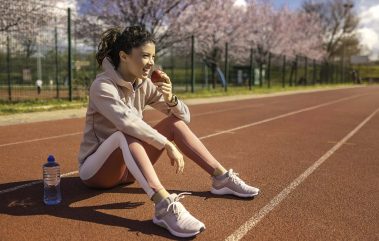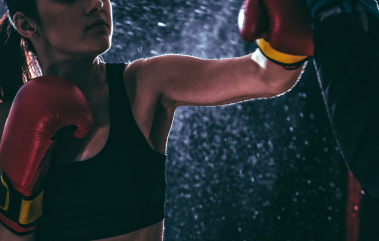Imagine being among the elite in your sport training with relentless dedication, mastering your skills, and consistently pushing your limits. Now, envision being advised that to excel further, you must change your body, lower your weight, and restrict your food intake, even while intensifying your training. This scenario is all too real for many female athletes who confront intense pressures related to nutrition, weight, and body image.

Heather Caplan and the Lane 9 Project
Heather Caplan, Alexis Fairbanks, and Samantha Strong, all accomplished runners, once fell into this trap. They, like many athletes, were convinced that being lighter meant being faster and stronger. This misconception led to a serious condition known as hypothalamic amenorrhea, where menstruation ceases due to insufficient energy intake. As their rigorous training continued alongside poor nutritional practices, their health suffered significantly, impacting both their performance and well-being.
In response, they established the Lane 9 Project, a nonprofit organization dedicated to aiding female athletes dealing with nutrition-related challenges. Their mission is to raise awareness about the dangers of energy deficiency and advocate for a balanced approach to nutrition and athletic performance. Their initiative has motivated many athletes to prioritize their health over unrealistic body ideals.
Mary Cain: The Dark Side of Elite Sports
Mary Cain’s story illustrates the severe consequences of improper nutrition. As a promising young runner, Cain joined the Nike Oregon Project at 17, where she faced immense pressure to lose weight for better performance. Despite being assured that weight loss would enhance her running, Cain’s health deteriorated quickly.
Her menstruation ceased, she developed osteoporosis, and her athletic performance faltered. The relentless drive for weight loss, combined with poor nutrition, took a heavy toll on her physical and mental health. In 2019, Cain courageously shared her experiences, highlighting the damaging practices in elite sports and underscoring the critical need for proper nutrition.
RED-S and Its Hidden Consequences
What Cain and many other female athletes endure is part of a broader issue called Relative Energy Deficiency in Sport (RED-S). RED-S occurs when athletes do not consume enough calories to meet their training demands, leading to a range of problems such as fatigue, compromised bone health, weakened immune function, and even cardiovascular issues.
RED-S affects more than just short-term performance; it can have long-lasting effects on an athlete’s health. For example, missed periods, while seemingly minor, are indicative of significant hormonal imbalances that can lead to severe long-term health problems.

The Role of Coaches and Support Systems
A major issue is the lack of proper education and support regarding nutrition for female athletes. Coaches, who may not fully understand the complexities of female nutrition, might inadvertently worsen the situation by focusing too much on weight or appearance rather than overall health.
A Beacon of Hope: Mikaela Shiffrin’s Advocacy
Mikaela Shiffrin, one of the world’s leading skiers, offers hope in the fight for better nutritional practices. Despite facing pressures to maintain a slim physique, Shiffrin has openly discussed her struggles with body image and nutrition. She advocates for a diet that supports performance rather than adhering to unrealistic body standards. Her openness helps normalize discussions about nutrition, encouraging athletes to focus on the fuel they need for optimal performance.
Shiffrin’s approach highlights the importance of viewing food as essential for fueling the body rather than as an adversary. By ensuring her diet meets the demands of her rigorous training, she has managed to sustain peak performance while avoiding the pitfalls of restrictive eating.
Taking Action: What Can Be Done?
Athletes, coaches, and sports organizations can take several steps to address issues like RED-S, eating disorders, and poor nutrition:
- Education: Athletes need comprehensive education about the risks of energy deficiency and the importance of balanced nutrition. This includes learning how to adequately fuel their bodies for training and recovery.
- Support Systems: Providing access to nutritionists, psychologists, and other professionals is essential for helping athletes maintain a healthy relationship with food. Initiatives like the Lane 9 Project play a crucial role in fostering a supportive environment for female athletes.
- Changing the Conversation: Coaches must shift their focus from weight and body image to fueling performance and overall health. This change in perspective can help prevent eating disorders and promote long-term well-being.
Author Renu Yadav Currently diving deep into sports nutrition and management in Mysuru, Renu is preparing to bring fresh insights into women’s sports. She is keen on understanding the real-world challenges faced by female athletes to help them reach their pinnacle. Driven by the desire to make a tangible difference in the lives of female athletes through nutrition and education, Renu is excited to be a part of this.




